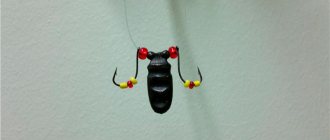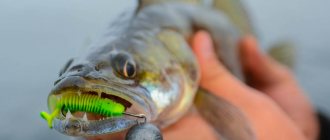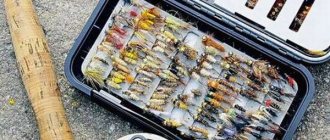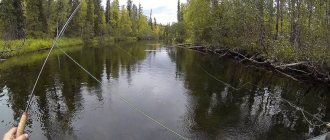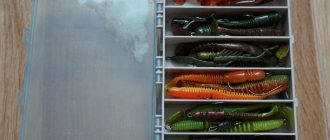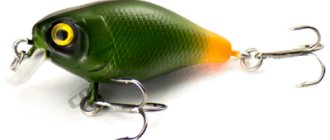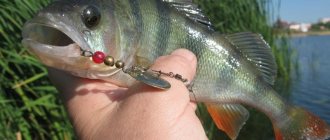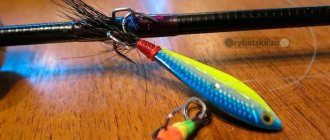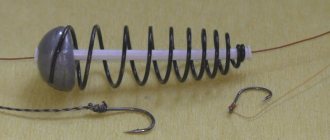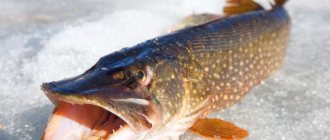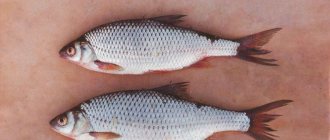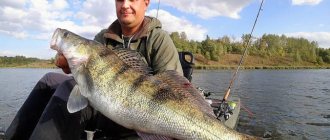Yuri 11/24/2020 259
Composite wobblers are artificial baits that have the natural appearance of fish. They usually consist of two or three parts (rarely more), connected to each other by hinges. They appeared in the arsenal of many spinning anglers relatively recently, but have firmly occupied their niche among other baits.
Another common name for a unique bait is a swimbait. This is a derivative of two English words: swim, which means “swim” and bait, that is, “bait”. Quite often, such artificial baits are given as birthday gifts to avid spinning fishermen. Such a gift looks aesthetically pleasing and has practical benefits.
Peculiarities
Swimbaits
By and large, this is an almost complete copy of a live fish. This could be trout, perch, roach, crucian carp, and many other types of fish. The main task for the fisherman is to determine what food supply the predator has in a particular body of water. And, based on this, select the type of bait.
The style of play of the swimbait is already implied in its name. The swimbait floats with an even retrieve, of course, very appetizingly. And as soon as you make small jerks with the spinning rod, the plastic fish seems to come to life and appear before the fisherman and predator in all its glory.
A swimbait can consist of two or three sections, or many. If a swimbait has many components, its movements will be a little smoother, but the essence and swimming character of this bait does not change much.
Another very important characteristic of this class of baits is their negative buoyancy. In some it is more pronounced, in others less, but in any case, any swimbait is bound to sink. Since, due to the lack of a blade, it simply will not be able to go deeper into the water column in any other way.
How to choose a swimbait?
The choice of a specific model of a composite wobbler depends on the conditions of the reservoir where you plan to fish.
For catching pike or asp in areas with shallow depth, as well as in locations overgrown with aquatic vegetation in the lower water horizon, floating baits are suitable. At the very beginning of the drive, such wobblers are immersed to a given depth, in accordance with their characteristics. And when paused, they slowly emerge.
When hunting for large pike and trophy perch, larger wobblers are used. Their animation is more similar to a walker, but should be a little less aggressive to avoid snags.
Among the large army of spinning anglers, there are quite a lot of trolling enthusiasts. Therefore, such followers of line fishing should be warned that most composite wobblers are practically unsuitable for solving such problems. This especially applies to fishing in deep areas of the water area.
Summarizing the above, we can conclude that fishing with compound wobblers is an interesting and very enjoyable activity. If you are one of the followers and adherents of spinning fishing, adding a swimbait to your arsenal is definitely worth it.
TAGS:
Fishing with swimbaits
Most swimbaits are designed in such a way that they do not have a blade; to an angler who has fished with wobblers before, this may seem quite unusual. When fishing with a swimbait, you will not feel the pressure on the spinning rod that occurs when fishing with a wobbler. But you get used to it pretty quickly. But when fishing with a swimbait, you feel even the slightest pull, which is quite difficult to achieve when vigorously moving a wobbler, and even one equipped with a blade. When the water pressure on the swimbait is reduced, it can lunge to the side, similar to a jerk bait. If this is your first time fishing with a swimbait, then passing it along the boat, you can watch the lively play of the bait. But one game is often not enough to force predatory fish to bite. By twitching the tip of the spinning rod, you make the swimbait play more naturalistic than simply reeling in the line. When you twitch the swimbait every two or three meters, the bait will make sharp lunges to the right and left. If you pause while retrieving and then jerk the rod again, the swimbait will again sharply move to the side; the movement of this bait cannot be confused with anything else. But don’t be overzealous with twitching; two times is enough at a distance of 4-5 meters. Wiring should be done at different speeds, first at a normal pace, then at a distance of several meters at a slow pace.
If you are fishing in a snag, then you shouldn’t be particularly afraid of hooks, because a swimbait has one advantage: it quickly floats up and avoids underwater obstacles. One pull with the spinning rod will be enough for the bait to appear on the surface of the water. Retrieving at a very slow pace perfectly activates inert pikes in the cold winter. And in summer, this bait effectively catches on the surface, if the rod is held high enough; you can also fish with a swimbait above thickets of aquatic plants, if they do not come too close to the surface of the water. But most sinking swimbaits without a blade have one drawback: they are not suitable for trolling, especially for fishing in deep areas of the reservoir. The problem is that they quickly rise to the surface; you can force the swimbait to dive deeply only by equipping it with an additional sinker in front of the leash. Depending on the depth of immersion, its weight can be from 20 to 40 g. In the summer, a lot of algae floats in the water, which cling to the bait and reduce its play. The sinker will collect grass and the swimbait will remain free of water debris. And getting rid of algae clinging to the sinker is quite simple; just a few energetic jerks are enough. And you will always have a catch, following these simple rules for fishing with a wonderful swimbait lure.
Swimbait fishing gear
The classic tackle for fishing with swimbaits is, of course, a multiplier, due to their large size. But since today we are talking about their smaller brothers, adapted for Russian conditions, the choice of gear does not require a specific approach. A regular wobbler rod with a spinning reel will do.
When retrieving, a swimbait, even having an impressive size, is not stubborn in the water, so it does not put a strong load on the reel. Still, it’s better to have a fairly powerful set, because fish that are not small can bite. Despite the fact that it is also not necessary to make powerful jerks with the rod, it is still better to use fairly rigid spinning rods. This is justified by better control, bait control and reliability when landing fish.
Meet the swimbaits
Experienced spinner Bertus Rosemeier shares his opinion on swimbaits.
New lures
Swimbaits are new baits. Their appearance is due to new technologies and materials that make it possible to create exact copies of living fish. But the main thing is that swimbaits don’t just look like small roaches, roaches and perches, they imitate with their game the movements of fish in the water, thereby making it easier for the angler to catch a predator. No special skills are required from the fisherman, but you will have to fork out some money, because baits are not cheap.
What applies to swimbaits?
I can classify swimbaits as two groups of baits. The first is what we used to call multi-component baits. Such fish imitations usually consist of two or three parts fastened together. I think modern swimbaits should have more than three parts.
This is the second group of baits, which are very technologically advanced and the developers have achieved in them an exact copy of the behavior of fish in water. In fact, such bait catches fish instead of the fisherman and, as a rule, does not require any special skills in using tackle. Therefore, even novice fishermen, not to mention experienced spinning anglers, can have great luck with such a bait. Ease of fishing is what a swimbait is all about.
Wiring technique
But even at the same time, the angler still needs to master some technique of playing with swimbaits in order to revive this plastic fake. If you see with your own eyes the play of a swimbait in the water, you will most likely be amazed at its excellent action. But, unfortunately, very often this is not enough to catch a large pike.
The main thing is to make the swimbait move in the water just like a live fish. Sometimes you need to master a completely new wiring technique and discard old stereotypes. But this is a normal process, isn’t it? We all, having acquired a new fishing bait, strive to ensure that it becomes catchy in our hands. Therefore, you should not be alarmed about this.
Rod selection
In practice, swimbaits have proven their effectiveness. They allowed me to catch a lot of trophies and I think that this will happen again in the future.
You need to start mastering swimbaits by selecting a fishing rod. At first, you can try fishing with ordinary spinning rods equipped with an inertia-free reel. But in this case, crossing the leash over the bait simply will not give life. And not all types of swimbaits can be used with a light rod.
After all, the weight of some models reaches 100 grams. For example, small baits in the range of 13-18 cm can weigh more than 60 grams. Therefore, the choice of rod takes place. For fishing with swimbaits, a powerful jerbait rod equipped with a multiplier reel is suitable.
We use twitching
Many swimbait models are not equipped with a blade, so they offer significantly less resistance when retrieved underwater. Those anglers who have previously used bladed wobblers may experience temporary difficulties when fishing with swimbaits.
But you can quickly get used to it. In addition, low resistance gives the swimbait some advantage over bladed wobblers. Now you can record even the slightest bite.
As they said, even monotonous fishing with a swimbait gives you a chance of catching a predatory fish. But if the game is diversified with the help of twitching, then game options that are very attractive to fish will arise. A jerk with the rod causes the swimbait to curl in one direction, but after a pause of one second the bait will again return to its original position. Simply amazing options arise. True, you don’t need to overdo it with a variety of retrieves, you’re fishing with a swimbait! Matching the game takes some practice.
Slow wiring
Swimbaits without a blade work great with very slow retrieves, which can be very useful for catching pike in cold water when the fish loses its former mobility. Fishing for pike with swimbaits in these conditions can be extremely effective. Move the bait about two meters at normal speed, and then at very slow speed. This is an interesting tactic that brings success.
Also, a swimbait without blades is a floating bait, which is useful when there are snags in the water. If the bait rests on something, just lift the rod and the swimbait will float up.
Wiring near the surface
In warm water, a swimbait can very easily be made to swim close to the surface. To do this, just lift the spinning rod up. If there is not too much grass in the water, then this will be the most excellent surface bait. I've been able to catch more fish with swimbaits than with other topwater lures.
Wiring at depth
But this is also a bit of a disadvantage if you want to troll with swimbaits. The problem especially arises when fishing at depth - the bait constantly floats higher. We'll have to look for a solution by installing an additional weight in front of the leash.
I install an additional weight, the weight of which, depending on the trolling depth, usually ranges from 20 to 40 grams. At the same time, the sinker also solves the well-known problem of summer stringy algae. Now it will act as a buffer and will collect algae on itself, and the action of the bait itself will be less susceptible to changes due to foreign objects. It is also possible to knock algae off the sinker with a simple sharp hook, while the bait does not need to be removed from the water and it will remain on the fishing horizon.
The main difference between swimbaits with a blade
Swimbaits with a blade are not suitable for shallow depths, as they sink very quickly when retrieved to specified depths. The blade also acts as a brake when retrieving, and the smooth play of the swimbait may be lost. Therefore, from bladed swimbaits you need to choose baits with stable action.
From my practice, I concluded that bladed swimbaits are a completely different bait compared to swimbaits without a blade. You need to select a specific game key for them. Personally, I was a little disappointed with these baits. But the advantage of a swimbait with a blade is the possibility of excessively slow retrieval of such a bait.
For example, slowly reel in the reel, make a few gentle twitching movements with the rod, then continue with a slow retrieve. Swimbaits give you the opportunity to look for the best options. Search, fantasize and you will not be left without a catch.
Basic properties of bait
Not everyone knows what a swimbait is. It has many characteristics and various properties. There are two types that every fisherman should have in his collection:
- sinking;
- floating.
It is good to use floating baits in shallow waters, since at the beginning of the retrieve they sink to a certain depth, and during a pause they evenly rise to the surface.
Appearance of the bait
Regarding sinking wobblers, a pause in the retrieve should be excluded. Then the shallow hunt will be successful. But this type of swimbait is best used at depth. They are characterized by monotonous fishing, which copes well with catching active pikes. And here, to conquer the required depth, the fisherman should make 3-4 pull-ups and short pauses lasting two to three seconds.
It is also worth noting that sinking lures are not suitable for trolling.
To understand why a swimbait is useful, you should familiarize yourself with its main characteristics:
- the appearance is as close as possible to the image of real fish;
- can sink slowly or at medium speed, imitating the movement of fish;
- floating baits can slowly float up, thereby attracting pikes to themselves;
- they can float up very quickly, thereby avoiding obstacles under water, making it possible to fish anywhere, regardless of how well the bottom is maintained;
- the intensity of swimming is regulated due to the structure and components, which gives fishermen the opportunity to catch a pike in time and not miss it;
- sizes are small, medium and large (for example, 60 grams and 18 centimeters are the dimensions of a large wobbler, which often catches pike weighing 0.5 kilograms).
But, as you know, there is no limit to perfection. Fishermen are recommended to use various manipulations to improve their hunting assistant.
The bait has a number of positive aspects
